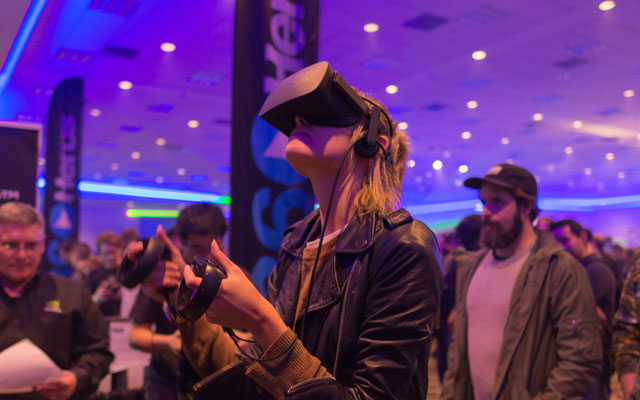Globibo's Felix Rimbach likens Virtual Reality (VR) to Play-Doh, where the latter was supposed to be a wallpaper cleaner, but later found success later as a child's toy. In the same way, he believes that the use of VR at events will one day be widespread
Play-Doh was developed in 1933. The product was supposed to help clean dirty wallpapers, and 20 years later Joe McVicker discovered that the formula of flour, water, and salt could be used as workable modelling clay. Finally, it was put on sale for kids in 1956.
Virtual Reality in events may go through its own Play-Doh phases right now. There are plenty of useful applications of VR during events (e.g. interactive product configuration and displays in exhibitions), but the system development and hardware cost to create truly immersive experiences appear to be only justified for media assets that can be used long-term.

Those types of assets are traditionally developed not from event organisations but from advertising agencies or in-house marketing teams. VR in the current concept of event management might be just cleaning the dirty wallpapers.
On the other hand, it appears rather boring to think of VR only as a tool for the current event ecosystem. It might be significantly more interesting not to look from the position where we currently are to the future but look from the future back to where we are. From this perspective, VR will close some interesting gaps. As a matter of fact, VR appears to create opportunities that redefine the current event execution framework.
Here are two examples:
Flexible collaboration spaces: Conferences have become a creative space for discussions and collaboration on issues and solutions. The event setup permits not just the temporary teamwork of a unique group of experts but, very importantly, it has also become an accepted workspace and test-bed for new ideas and experiments.
VR now gives the participants a significantly more powerful canvas to try, simulate, and fail, and try, simulate, and fail, and try again. Imagine a Slack-&-TED online, in which you can significantly increase the reach and participation of global experts on a specific subject, even if they just step out from their lab for an hour. An environment in which exceptional thinkers can simply work on a topic multiple times even if it breaks. Could VR maybe create a space of unique collaboration as a subsequent next step of current conferences?
Imaging a sophisticated virtual environment of exhibitors, product experiences, social experiences, moderated discussions, experiments and other content that is dynamically generated and morphing to participants’ interactions and preferences. Already today you can join a circle of friends to experience virtual environment jointly (unfortunately those environments are still very basic). Once all currently existing technologies are combined, an event may not require any space at all. Existing revenue streams from hybrid events solidify and entirely self-driven virtual conferences may crystallise new market segments.
The way we think of VR is as a tool that can improve our current event experience. We try to answer what can be done better of what we already do. In this context, the applications remain rather limited and expensive marketing gimmick that slowly loses its appeal. If we think of VR as a tool that creates an entirely new context, the technology may become our next Play-Doh blockbuster.
So what’s next? How do you get involved?
- Create 360-degree immersive VR channels into your events: Upstream from a well-positioned 360-degree camera into a private live-stream channel (e.g. YouTube). Test different headset experiences internally and how remote participants can contribute to and benefit from your programme.
- Foster remote (onsite and offsite) contributions before, during and after the event: Provide infrastructure for contributions (e.g. Audience Response Solutions) and processes to immediately engage with such contributions.
- Train your facilitators and moderators to fully integrated remote ad-hoc content into your event: Train and motivate moderators to leverage online content naturally as well as how to manage technical issues.
- Create prominent visibility within the venue of online collaboration spaces: Make the virtual experience look physical, potentially with large screens and monitors that display online interactions.
- Motivate and moderate online-offline content integration: Set specific goals and define direct responsibilities for individuals to generate value from online-offline integration.
- Provide VR based “play-stations” within event venue to experience virtual access: Create zones in which onsite participants can learn about non-physical presence.
- Remain hardware-agnostic on VR headsets and development frameworks: Do not focus on specific hardware and software platforms but processes that add value to your participants, speakers, and exhibitors.
The above steps will provide safe-zones for the organiser to learn, without creating much of operational risk. Play-Doh was also not invented to be one of the most successful children modelling compounds. It started somewhere and morphed to this function. VR can start with small stepping stones which might not require VR headsets or programming. After all, the market for VR-driven events will be there, the question is only, will you still try to sell a product to clean wallpapers at that point in time?

Felix Rimbach is the regional director for research & development at Globibo, responsible for around 1,200 projects throughout Asia, Europe and North America each year. His key focus area is the marketing impact of technology solutions with special attention to learning, collaboration and communication. Rimbach is also one of the leading researchers on AI architectures, modelling and knowledge representations.





















